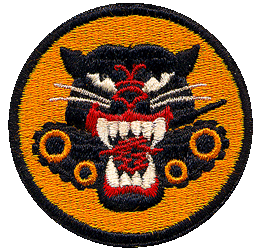 Benjamin A. Bailey
Benjamin A. Bailey
Biography: Benjamin Alston Bailey, “Bill”, was born on November 9, 1902, in Pittsylvania County, Virginia. He was one of eleven children born to James Robertson Bailey and Martha “Pattie” Alderson. James was married twice, originally to Malissa E. Wood in 1882, and then to Bill’s mother, Pattie Alderson in 1899.
Service Time:As identified by the 1936 National Guard Register, Bill enlisted in the National Guard in August 1922, serving in the 29th Infantry Division, specifically in the 29th Tank Company, which was based in Danville, VA. He worked his way through the enlisted ranks to First Sergeant by September 1, 1930, and was promoted a 2nd Lieutenant on February 5, 1935.
On October 18, 1927, Bill married the former Nancy Elizabeth Newell who was the daughter of Wilson P. Newell and Ida J. Hays. The couple had a son, Alston, born in 1937. The family made their permanent home in Danville, VA. In his civilian life, Bill had a position with the C&O (Chesapeake and Ohio Railway). Bill was also a member of the Morotock Mason Lodge #210 in Danville.
On July 24, 1936, he was promoted to 1st Lieutenant and completed the Officer’s Tank Course. He was promoted to Captain on October 19, 1938, and due to the impending war the division was called into active service on February 3, 1941. Bill was promoted to Major on June 19, 1942.
We are not sure how the now Lt. Col. Bailey transitioned into the 4th Armored Division but he was commended by both the Commanding General of the 4th Armored Division, Major General John S. Wood, and the Commanding Officer of the 37th Armored Regiment for his “outstanding duties as the officer in charge of meeting and unloading railway trains on the arrival of the unit to Camp Bowie, TX.” on June 3, 1943. Camp Bowie at the time was an armored training center located near Brownwood, TX. The unit would then depart for Camp Myles Standish, Massachusetts, for winter training. On December 29th, the 4th AD departed Boston to conduct training in England in preparation for the invasion of Normandy.
While overseas, we know that Lt. Col. Bailey was commanding the 35th Tank Battalion, which had originally been the 35th Armored Regiment. It was re-designated as the 35th Tank Battalion on November 12, 1943, and served as part of the 4th AD. The 4th AD was successful in action near Orleans, France, and was performing maintenance and receiving replacement troops. It was at Orleans that five officers of the 704th Tank Destroyer Battalion, including its commander, Delk Oden were transferred to the 35th Tank battalion while Lt. Col. Bailey was transferred to the 704th along with company Captains Dunton, Lamb, Onkes, and Lt. Tytus. Captain Onkes would became the unit’s S-4 (logistics) officer, Captain Dunton became the S-3 (operations), and Lt. Tytus the S-1 (administrations) officer. Captain Lamb assumed command of the Headquarters Company.
On September 1, 1944, the Lorraine Campaign began and units of the 704th would quickly advance to the city of Luneville, France. It was on the 19th that the unit history identifies the following:
“Company B came up against eight German Mark V tanks, supported by infantry, made a counters attack to regain a foothold in the city (Luneville). The third platoon fought it out at close quarters. A bridge across the railroad tracks just south of town proved to he the bottleneck for the Kraut attack. Sgt. Mankin maneuvered his tank into position, fired pointblank and destroyed an enemy tank, traversed rapidly, fired again, and reduced another tracklaying pillbox to a lifeless hulk. Sgt. Monaco and Czytajlo accounted for three more tanks, the latter getting two in fast, furious action. The counterattack was beaten off without the loss of a tank and with only five shellfire casualties, The next day dawned cold and wet and with it came a concentrated, continuous pounding by guns and mortars that caused fourteen casualties. Enemy infantry and tanks got into the town from the East, and street fighting raged throughout the night. “B” Company knocked out a Ferdinand (SP) and a heavy machine gun. “C ” Company sent in a platoon to help and promptly KO’d a Mark V tank. Relief by the 6th Armored Division was welcome. But the relief was out of one hot spot into another – the Arracourt area.”
It was during the fighting on the 19th that at 1200 hours, Lt. Col. Bailey and his Sergeant (driver) arrived in a Jeep at the bottom of the Rue de Viller, on the west side of town. The Sergeant drove quickly through the intersection and turned right in front of where the American tank destroyer units were positioned, which was directly into the field of enemy fire. Lt. Col. Bailey raised his hand to give orders to Captain Tanner, the Company Commander, and a mortar shell exploded near the vehicle. Lt. Col. Bailey was killed by shrapnel but his driver survived.
 “Lt. Col. Hyde took command of the Battalion for a short period, received orders for home, and relinquished command to Lt. Col. Alanis”.
“Lt. Col. Hyde took command of the Battalion for a short period, received orders for home, and relinquished command to Lt. Col. Alanis”.
Lt. Col. Bill A. Bailey was temporarily buried in cemetery #3504 (Saint James Permanent Cemetery, Saint James, France) Block E, Row 10, Grave 226, and then reinterred in the Lorraine American Cemetery in Saint-Avold, France, Plot C, Row 18, Grave 30. He was awarded the Silver Star and received the Purple Heart posthumously. In recognition of his actions and death during the liberation of Luneville, a dark blue plaque was hung outside a shop in the town. It reads:
************************
In memory of Lieutenant Colonel Bill Alston BAILEY
Commander of the 704th Tank Destroyer Battalion
He fell here for our freedom on September 19, 1944.

